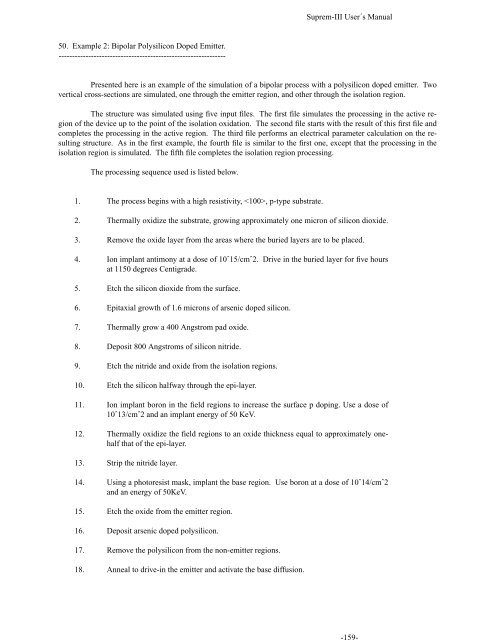Suprem III - Stanford Technology CAD Home Page
Suprem III - Stanford Technology CAD Home Page
Suprem III - Stanford Technology CAD Home Page
You also want an ePaper? Increase the reach of your titles
YUMPU automatically turns print PDFs into web optimized ePapers that Google loves.
-159-<br />
<strong>Suprem</strong>-<strong>III</strong> User´s Manual<br />
50. Example 2: Bipolar Polysilicon Doped Emitter.<br />
--------------------------------------------------------------<br />
Presented here is an example of the simulation of a bipolar process with a polysilicon doped emitter. Two<br />
vertical cross-sections are simulated, one through the emitter region, and other through the isolation region.<br />
The structure was simulated using five input files. The first file simulates the processing in the active region<br />
of the device up to the point of the isolation oxidation. The second file starts with the result of this first file and<br />
completes the processing in the active region. The third file performs an electrical parameter calculation on the resulting<br />
structure. As in the first example, the fourth file is similar to the first one, except that the processing in the<br />
isolation region is simulated. The fifth file completes the isolation region processing.<br />
The processing sequence used is listed below.<br />
1. The process begins with a high resistivity, , p-type substrate.<br />
2. Thermally oxidize the substrate, growing approximately one micron of silicon dioxide.<br />
3. Remove the oxide layer from the areas where the buried layers are to be placed.<br />
4. Ion implant antimony at a dose of 10ˆ15/cmˆ2. Drive in the buried layer for five hours<br />
at 1150 degrees Centigrade.<br />
5. Etch the silicon dioxide from the surface.<br />
6. Epitaxial growth of 1.6 microns of arsenic doped silicon.<br />
7. Thermally grow a 400 Angstrom pad oxide.<br />
8. Deposit 800 Angstroms of silicon nitride.<br />
9. Etch the nitride and oxide from the isolation regions.<br />
10. Etch the silicon halfway through the epi-layer.<br />
11. Ion implant boron in the field regions to increase the surface p doping. Use a dose of<br />
10ˆ13/cmˆ2 and an implant energy of 50 KeV.<br />
12. Thermally oxidize the field regions to an oxide thickness equal to approximately onehalf<br />
that of the epi-layer.<br />
13. Strip the nitride layer.<br />
14. Using a photoresist mask, implant the base region. Use boron at a dose of 10ˆ14/cmˆ2<br />
and an energy of 50KeV.<br />
15. Etch the oxide from the emitter region.<br />
16. Deposit arsenic doped polysilicon.<br />
17. Remove the polysilicon from the non-emitter regions.<br />
18. Anneal to drive-in the emitter and activate the base diffusion.















